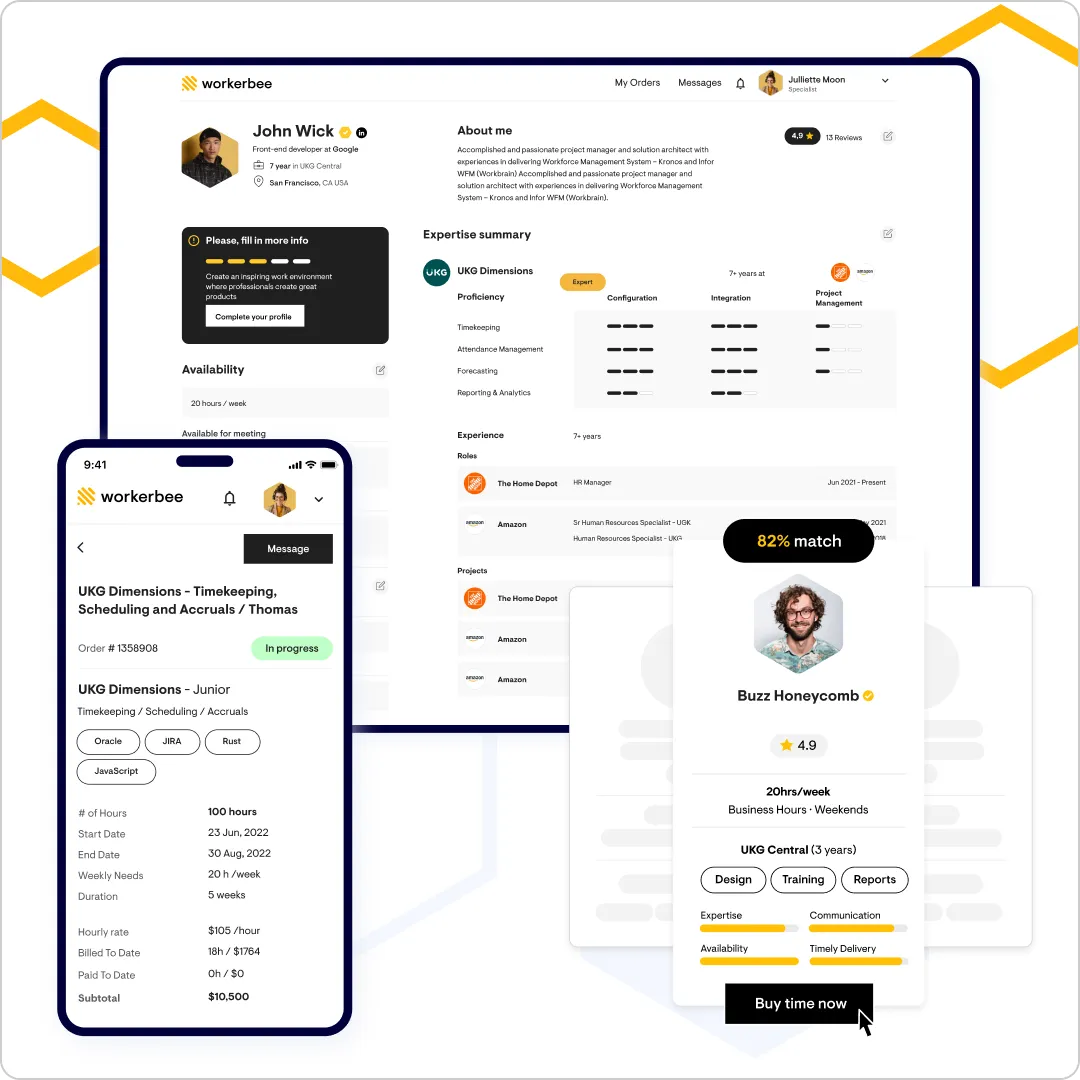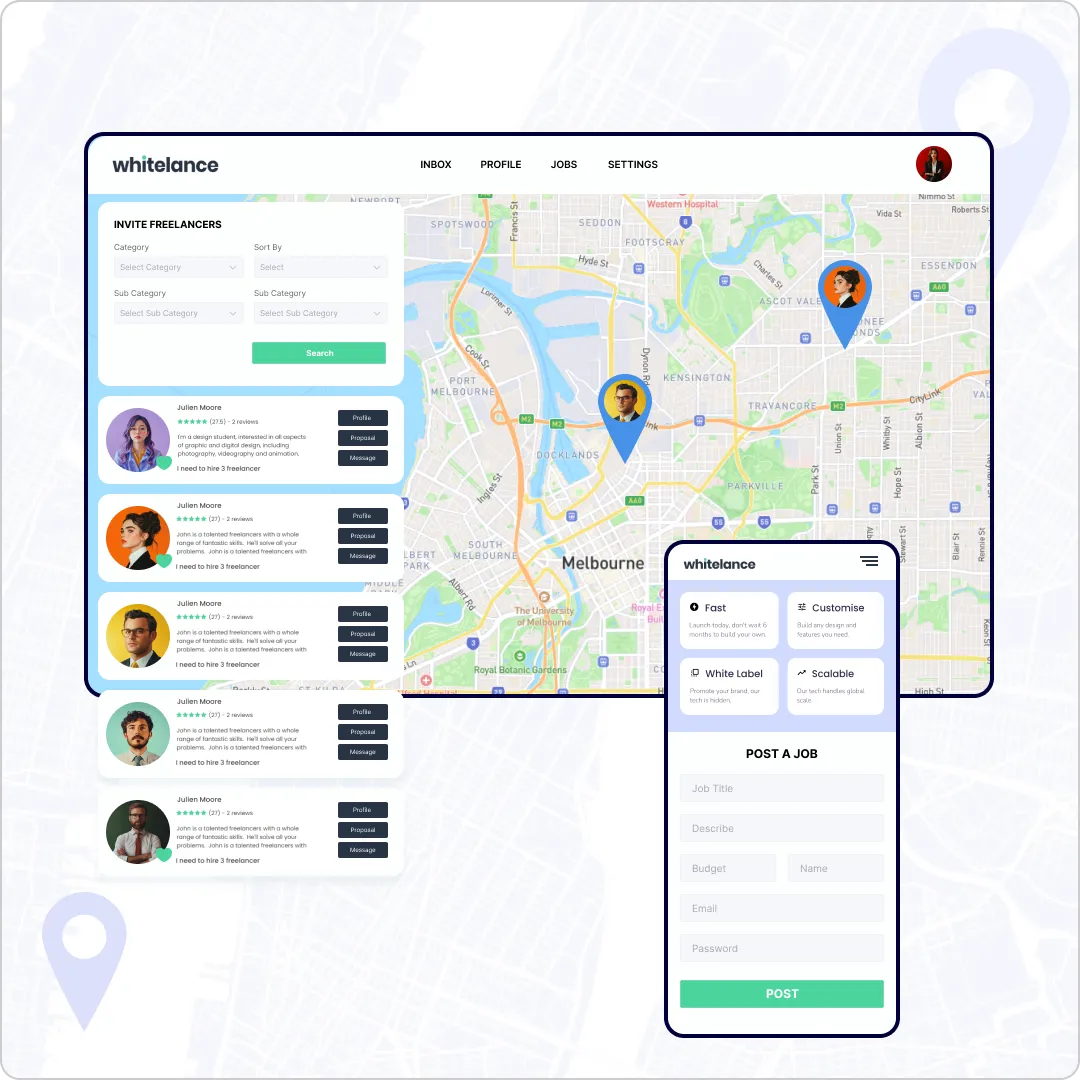Online Marketplace Development Services
We build B2B marketplaces from MVP to multi-tenant platforms, combining scalable architecture, clean integrations, and optional AI for real workflows.

Fortune #40 Global Health Leader
1886-founded | 131K employees | $16B in R&D

NYSE: EB
850k creators | 300M tickets sold in 2023

8th GPS App in the US
3M+ in 2023 | 10M+ Google Play downloads

Cultural Exchange Led by 2K+ Team
Est. 1980 | 500K+ Alumni | 100+ Countries

$12M Revenue Tech Co.
MBE Certified by NMSDC

Trusted Logistics Co. Since 1979
ISO9001 Certified Systems Integrator

3rd in Retail Inc. 5000
$6M+ raised | #1 ranked company in CT

UCSF-Trusted Health App
with 50K+ users in 60+ countries

Google-Funded Green Tech
144K Ha Monitored | Featured by Reuters

Telecom Experts Est. 2005
Google, Proximus & Orange partners

NASA-Trusted Workflows Builder
Est. in 2007 | PCI, GDPR & HIPAA certified

Top Swiss Agency
Awarded #1 Swiss App in 2025

#2 SMM Agency in Australia
Serves 1k+ Australian B2B across 20+ domains

Google Cloud Partner
Trusted by Fortune 5 UHG

F&B Startup with 25K+ Guests/Y
4.5 on TripAdvisor | 600+ Dining Partners

Fortune #40 Global Health Leader
1886-founded | 131K employees | $16B in R&D

NYSE: EB
850k creators | 300M tickets sold in 2023

8th GPS App in the US
3M+ in 2023 | 10M+ Google Play downloads

Cultural Exchange Led by 2K+ Team
Est. 1980 | 500K+ Alumni | 100+ Countries

$12M Revenue Tech Co.
MBE Certified by NMSDC

Trusted Logistics Co. Since 1979
ISO9001 Certified Systems Integrator

F&B Startup with 25K+ Guests/Y
4.5 on TripAdvisor | 600+ Dining Partners

Google Cloud Partner
Trusted by Fortune 5 UHG

#2 SMM Agency in Australia
Serves 1k+ Australian B2B across 20+ domains

Top Swiss Agency
Awarded #1 Swiss App in 2025

NASA-Trusted Workflows Builder
Est. in 2007 | PCI, GDPR & HIPAA certified

Telecom Experts Est. 2005
Google, Proximus & Orange partners

Google-Funded Green Tech
144K Ha Monitored | Featured by Reuters

UCSF-Trusted Health App
with 50K+ users in 60+ countries

3rd in Retail Inc. 5000
$6M+ raised | #1 ranked company in CT

Trusted Logistics Co. Since 1979
ISO9001 Certified Systems Integrator

$12M Revenue Tech Co.
MBE Certified by NMSDC

Cultural Exchange Led by 2K+ Team
Est. 1980 | 500K+ Alumni | 100+ Countries

8th GPS App in the US
3M+ in 2023 | 10M+ Google Play downloads

NYSE: EB
850k creators | 300M tickets sold in 2023

Fortune #40 Global Health Leader
1886-founded | 131K employees | $16B in R&D

F&B Startup with 25K+ Guests/Y
4.5 on TripAdvisor | 600+ Dining Partners

Google Cloud Partner
Trusted by Fortune 5 UHG

#2 SMM Agency in Australia
Serves 1k+ Australian B2B across 20+ domains

Top Swiss Agency
Awarded #1 Swiss App in 2025

NASA-Trusted Workflows Builder
Est. in 2007 | PCI, GDPR & HIPAA certified

Telecom Experts Est. 2005
Google, Proximus & Orange partners
Value we bring
Centralized supply & demand
Unify buyers, suppliers, and data in one platform to reduce overhead and keep transactions moving efficiently.
Automated deal workflows
Replace manual steps with structured automation to increase deal throughput without growing the team.
Built-in transparency & trust
Clear rules, shared data, and real-time status reduce friction, disputes, and uncertainty between sides.
New revenue & market reach
Move beyond local networks, attract more participants, and open new monetization paths as the platform scales.
Online marketplaces we developed
01 | 0401 | 04
Why choose us for marketplace dev?

Bogdan
Head of Delivery
When you’ve built several B2B marketplaces that operate under active user traffic, you start recognizing the same technical and operational challenges. Vendor logic, permissions, transactions, performance under load. On our last 6 platforms, knowing those patterns helped us design systems that scaled without delivery slipping past the original plan.
Proven B2B & B2C marketplace expertise
We’ve delivered 6 high-load, multi-vendor B2B and B2C marketplaces for SMB and enterprise clients. These platforms support complex workflows, large data volumes, and deep integrations, and are built to operate reliably in production.
Full-cycle development since 2014
We manage the full marketplace development lifecycle, from discovery and architecture to development, QA, and launch. One team works across all stages, reducing gaps and keeping decisions consistent throughout delivery.
Fast time-to-market
We validate assumptions early, focus on what really matters for your goals, and avoid unnecessary scope. This helps marketplace solutions go live faster while keeping the foundation solid for growth.
Built for long-term scaling and evolution
We design marketplace architectures so new features, integrations, and UX improvements can be added without disrupting existing workflows. The platform stays stable as usage grows.
Testimonials
01 | 0701 | 07
Our core marketplace expertise
Multiplatform consistency
Multi-tenant white-label architecture
High-precision matchmaking engine
Fast & secure checkout
Consistent UX for buyers and sellers
We deliver full feature parity across Web, iOS, and Android, so buyers and sellers get the same experience on every device. Our marketplaces run with 99.89% uptime, sub-second load times, and consistent UX, without platform-specific bottlenecks or duplicated development.

Bogdan
Head of delivery

Let’s build your marketplace without panic sprints
Our marketplace projects run with <10% CPI/SPI variance, giving you predictability and control, backed by our 10+ years of development experience.
Get in touch
AI capabilities for marketplaces
AI features designed to reduce manual work, improve relevance, and support better decisions across marketplace workflows.
Smart matching
Surface the most relevant buyers and suppliers using product data, behavior signals, and deal history. Match accuracy improves by 25–40%, manual review drops by up to 50%, and qualified connections increase by 15–20%, without changing existing marketplace logic.
Product categorization and data cleaning
Keep marketplace data structured and consistent at scale. Automated classification and normalization reduce moderator workload by 30–60% and improve search quality, navigation, and overall data reliability.
Buyer inquiry routing
Route complex buyer requests to the right suppliers based on context, requirements, and constraints. Faster responses, less lead loss, and a better experience for both buyers and suppliers, without manual triage.
Contract and document extraction
Turn contracts, invoices, tenders, and specifications into structured data. Reduce manual processing and errors while accelerating deal workflows, with human review kept where it adds value.
Marketplace development process
Here’s how we bring your product to life:
1. Discovery: Set the foundation
We start by deciding on the optimal tech approach to build a marketplace that matches your goals. From functionality breakdown to detailed product requirements, architectural design, and risk register, we consider every detail and confirm it with you. By the end, you’ll have a clear, actionable plan that shows exactly how we’ll bring your vision to life, without surprises.
2. Design: creating seamless user experiences
A great marketplace balances ease of use with a design that catches attention. We focus on user-friendly navigation, intuitive flows, and an attractive visual style that sets your marketplace apart.
Before moving forward, we’ll share wireframes and an interactive prototype, giving you the opportunity to explore the design firsthand. Your feedback guides the final touches, ensuring everything looks and feels exactly as you envisioned. Whether it’s guiding users through complex workflows or adding elements that make your brand memorable, our goal is to deliver a design that works for your audience and business.
3. Development: Bring it to life
Our marketplace platform development is based on transparency and expertise. Our developers bring 10 years of experience in building B2B, B2C, and C2C marketplaces to create your platform from the ground up. We set up a scalable infrastructure that can handle growing traffic, implement functionality and design in code, and integrate your marketplace with third-party tools, configuring APIs to work exactly as you need.
By following PMI standards and agile practices, we keep your project on track and deliver everything on time and within budget, even if unexpected changes come up in the process.
4. Testing: Polish the platform
It’s time to make sure your marketplace matches your quality metrics across all areas: functionality, security, performance, and usability. We identify potential issues, check if features meet product requirements, and fix the found flaws before launch.
For each project, we have a custom testing plan, so we do only what matters and brings value. It can be regular code checks for smaller projects or a full suite with automated tests, stress testing, and security audits for complex platforms. We approve the test plan with you at the start and follow it throughout the testing stage, ensuring no details are overlooked and no unnecessary steps are taken.
5. Deployment: Make your marketplace live
When your marketplace is ready, we focus on the product launch, which is a bit more than just hitting “go.” From coordinating the timing to handling last-minute adjustments, we’re there with you at every step.
After launch, our online marketplace development services don’t end. When you have feedback from early users, we’re quick to refine your platform, helping you align with the market demands and make sure the marketplace is ready for the long run.
6. Growth: Partner for the long run
Whenever you’re ready, we’ll be here to help you grow your business. Our team can take over refining features, adding new ones, enhancing user experience, or scaling the platform.
If you’re ready to wrap up, we’ll ensure a smooth knowledge transition with all documentation in place. However, if long-term collaboration fits your plans, we’re here to grow alongside your product, providing the flexibility you need to meet your objectives.
Marketplace app development cost
Discovery and prototype
$15,000 to $50,000
Refine your idea and validate it with a small-scale prototype.
Minimum viable product
$50,000 to $100,000
Start building your online marketplace with minimal initial investment.
Sales-ready product
$100,000 to $500,000
Launch a monetization-ready application.
Market-leading application
$500,000+
Prepare to beat the competition right away.
Marketplace development cost factors:
- Complexity of features
- Design requirements
- Required integrations
- Security requirements
- Supported platforms and devices
- Product development team composition
Adressing your doubts
Will the marketplace fit our business model and user needs?
Yes, that’s our goal when building a marketplace. We start every project by discussing with you your goals and any specific requirements you have for the platform. Based on this information, we define your platform’s functionality, how it will operate, and the criteria it needs to meet. Not sure how a feature must work to meet your user needs? Don’t worry, working on different marketplaces, we’ve seen what works best for users and businesses, so we’ll recommend the optimal way to implement functionality for your platform.
Can you migrate us from an existing platform to a custom one?
Absolutely. Migration is one of the services our online marketplace development company provides. We’ll first analyze your existing platform, data volumes and types, and necessary integrations. That way, we can plan migration carefully to avoid downtime or data loss. We’ll transfer everything (user accounts, listings, transactions), without interrupting your business operations and user experience on the platform.
Can it handle more users as we grow?
Yes, we build scalable platforms, choosing a tech approach that supports your marketplace growth: cloud-based infrastructure, efficient database solutions, and architecture designed to handle increasing user activity. The system can easily adjust, scaling infrastructure resources to meet the demand.
Will it integrate with payment gateways or shipping services?
Yes, we have integrations covered. At the start, we’ll assess your needs and the services you plan to use, diving into their APIs to ensure it’s possible to configure connections to your needs without problems. We’ve done 100+ integrations across our projects, so we’re already aware of the limitations and corner cases of multiple APIs. Plus, this experience helps us pick reliable options if you’re unsure what service to use.
How do you keep user data secure?
We adhere to a set of industry-standard security practices, including data encryption, multi-factor authentication, and role-based access control, to protect sensitive information. For marketplaces, we also handle specific concerns like keeping payments secure and managing personal data in line with region-specific regulations (like GDPR, for example).
If you have any specific requirements, we’ll take them into account as well. We discuss security requirements at the start of every project and outline necessary measures to meet them.
Can it support multiple languages or currencies?
Yes, if you need your marketplace to support multiple languages and currencies, we can implement it. That means handling translations and formatting dates, numbers, and addresses correctly. For payments, we can set up gateways like Stripe that let users pay in their preferred currency, ensuring a great experience regardless of their location.
How will you optimize it for SEO?
We take care to make your marketplace easy for search engines to crawl and rank. For example, we optimize page load speed, make the platform mobile-friendly, and implement metadata.
Can you meet our quality standards?
We clarify your quality standards at the start and outline system requirements and testing strategy with them in mind. During online marketplace app development, we keep quality in check with testing and share regular demos so you can see the mid-project results and provide feedback. Our agile approach lets us adjust if your requirements change, without compromising on quality. Thanks to this structured process, we have a 99.89% acceptance rate of our work.
How do you keep us in control throughout the process?
You’ll have full access to everything: documentation, design files, code repositories, Kanban boards, and more. Plus, our marketplace development services include frequent demos and sprint reviews, giving you the opportunity to review and approve work at every stage.
We also set up clear communication channels and regular calls with you. That way, your input is always included, decisions happen together, and any changes are agreed on upfront.
Do you help us retain expertise over the parts we outsource?
We keep detailed records of features, system requirements, technical approaches, and workflows so nothing gets lost. Your team will have full access to code repositories, documentation, and all deliverables.
Plus, if you plan to manage the marketplace in-house or switch to another marketplace development company after project delivery, we provide complete knowledge transfer sessions to make sure your team is ready to take over.
How can we be sure you’ll deliver exactly what’s agreed on?
We make sure everything we deliver matches what we agreed on. We define and document all requirements (features, designs, technical approach, and more) at the start of marketplace development and confirm them with you. As the project moves forward, you’ll have access to code repositories and documentation. Plus, we run regular live demos so you can see progress in real time and provide feedback on anything that needs adjusting.
Our track record speaks for itself: 99.89% of our work meets client expectations.
Will the team be consistent so they understand our product?
Most of our marketplace developers stick around for years, on average for 3.8 years. So the people who start a project usually see it through, getting a deep understanding of goals and technical needs.
If someone key does move on, we have knowledge transfer and onboarding processes in place. Everything critical is documented and shared, and new team members get up to speed fast, without disrupting the progress.
Can we take the outsourced code for internal maintenance?
We make sure you have full visibility and control over the code. You’ll have access to the repository, documentation, and all deliverables from the start. To make internal maintenance straightforward, we document the architecture, workflows, and key integrations. Our custom marketplace development services include a structured knowledge transfer process with walkthroughs, Q&A sessions, and technical handovers so your team can confidently manage the marketplace on their own.
Will language barriers affect communication?
98% of our clients are from the US and UK, and they say our communication is clear and efficient. We make sure technical details and project updates are always easy to understand. Plus, we set up a communication plan with defined roles, channels, and regular updates to keep everyone on the same page. Whether it’s messages, calls, or demos, we make sure communication stays smooth throughout the project.
Will we retain full IP ownership of the product?
Yes, you’ll keep full ownership of your marketplace. From the start, everything we create for your project belongs to you. Our contracts make it clear that the code, design, and all deliverables are entirely yours.
How do you endure stability, given the situation in Ukraine?
Our team is spread across multiple locations in Ukraine and abroad, which helps us stay fully operational without major interruptions. We’ve successfully scaled projects and maintained long-term contracts, keeping headcount and delivery consistent even during the war.
On top of that, our energy independence reduces downtime risk, so we can keep projects moving and maintain business continuity no matter what comes up.
How do you keep estimates accurate and our budget on track?
Our experience in marketplace development lets us set realistic timelines and budgets from the start. Because we’ve built marketplaces before, we can accurately estimate the time and resources each part of your platform will need.
During development, we track the Schedule Performance Index (SPI) and Cost Performance Index (CPI) to see how the project is progressing against the plan. If anything changes, we will review the impact on schedule and budget with you and make adjustments, so we stay on track. This method keeps our projects’ SPI and CPI variance under 10%.
Who we build marketplaces for
We support both growing teams and large organizations with marketplace solutions built to scale.
SMBs
Whether you’re launching a niche B2B or B2C marketplace or extending an existing platform, we build with scalability and monetization in mind. Our work includes multi-vendor marketplaces connecting specialists and businesses, white-label products designed for rapid onboarding of paying tenants, and more.
Enterprises
For established teams with complex workflows and high traffic expectations, we deliver marketplaces with advanced role logic, multi-tenant architectures, and integrations with external systems. We’ve built platforms that support tens of thousands of users, global expansion, and evolving business processes without compromising reliability.
Key people

Andrii
Founder & CEO
Clockwiser from Day 1 | Led Clockwise to Top Ukrainian IT Company

🎤 Karaoke champion
🧠 Quiz monster
🐈 Cat team

Bogdan
Head of Delivery
10 y. of experience | Set up delivery with 99.88% acceptance rate

🏂 Snowboarder
💿 DJ
🥁 Drummer
☕ Coffeeholic

Serhii
Head of Client Relations
11 y. of experience | 98% client satisfaction rate

🚞 Traveller
Gym rat
☕ Coffeeholic

Natalia
Head of People
10 y. of experience | 100+ hired talents

Hyggeist
Wanderlust Soul
🏊♀️ Swimmer
🕯️ Detail Aesthete

Mike
Solution Architect
15 y. of experience | 50+ projects with 99,99% uptime reliability

🧑🍼Father of 3

Pavlo
Tech Lead
15 y. of experience | Managed 40+ developers as Tech Lead

💨 Motorhead
🧰 Tinkerer
01 | 05
Awards

Top Software Development Company, 2025

Top IT Services Company, 2025

Listed Among Top 1000 Companies Globally

Top NodeJS Developers, 2025

Top Managed Service Provider in 2025
01 | 25
Focus on your business while we handle development
Trusted by 200+ clients, we deliver scalable solutions and do it with <10% CPI variance. Let’s talk about your needs.
Serhii
Head of Client Relations
Kateryna
Senior Account Executive
2014
Building products since
5
Clutch rating
98%
NPS score
5.5%
Annual employee churn rate
100%
Pleasure when working with us
6+ years
Retention of top specialists
Our value
Case studies
Why us?
Testimonials
Our expertise
AI expertise
Development steps
Development costs
FAQ
We build for
Technologies we use
Contact us











































































